You may be used to crushing can using foot or hand. Have you crushed it using an implosion?
Today were are going to explore effect of Atmospheric Pressure with ‘Crushing Can Experiment’.
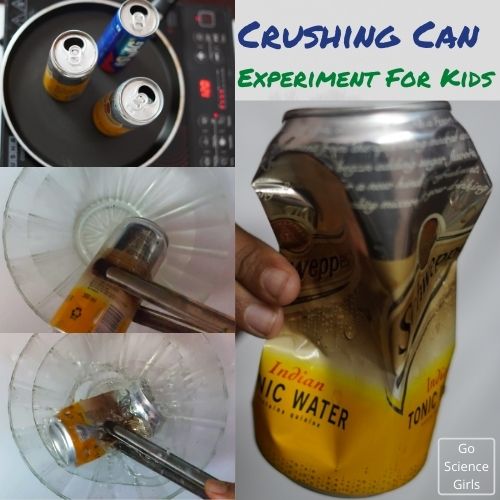
Air Pressure Can Crusher Experiment
The pressure created in the air surrounding us plays an important role while doing this activity.
Objective: To crush the empty soda can and explore simple science concepts like air pressure, equilibrium, water vapor, condensation, and unbalanced forces.
Hypothesis: If water in a can heated to reach its boiling point and then dipped by inverting in a cold bowl of water, this would create vacuum and result in decreased vapor pressure resulting in crushing of the can (implosion).
Safety Measures: Of course, the activity looks simple and easy while offering a lot of fun! But this experiment is in need of a burner or any other heat source and implosion happens suddenly. So, this experiment is not to be done by kids. However, under adult supervision, the activity can be explored.
Materials Mandatory to Gather:
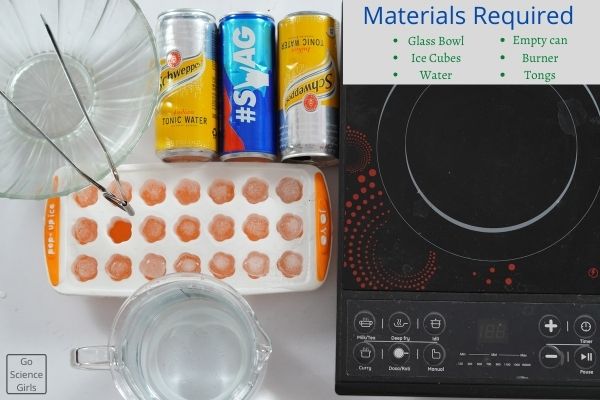
- A Glass Bowl
- Ice cubes
- Cold water
- Tongs
- Empty Cans (we chose 3 empty soda cans)
- Burner or Stove or any other heating source
Simple Guide to the procedure of the Crushing Can Experiment
Let us step into the simple instructions guide!
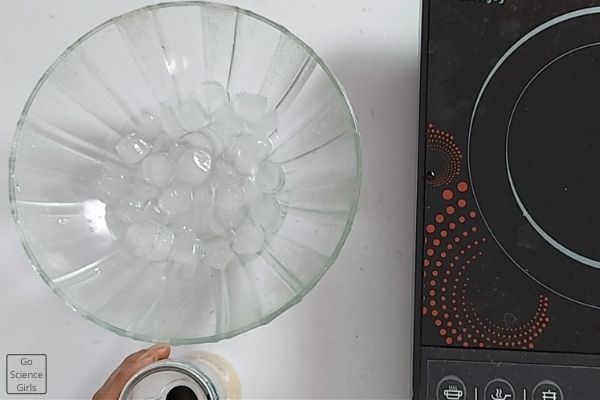
Step-1: Clean all the Necessary Containers
Cleaning is the foremost and important step to do before we start any experiment. Because the remnants attached to the glass bowls and other containers may change the final results of the experiment.
So, in the process of cleaning, pick the empty soda cans and glass bowls. And rinse them thoroughly with clean water. Make sure they are clean and perfect for using in the experiment.
Step-2: Pour Cold Water into the glass bowl
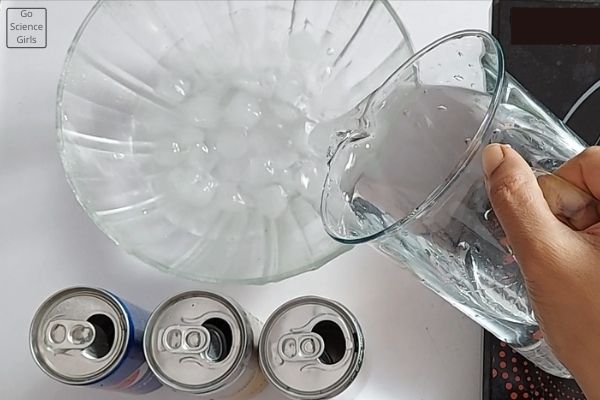
Take the cleaned glass bowl and fill it with fresh ice cubes to its half. Then pour some normal water into the bowl. Such that we are making sure the water in the bowl are cold for longer time.
Or else you can use cold or chilled water directly from the freezer and pour it in the glass bowl.
Step-3: Fill the Empty Cans
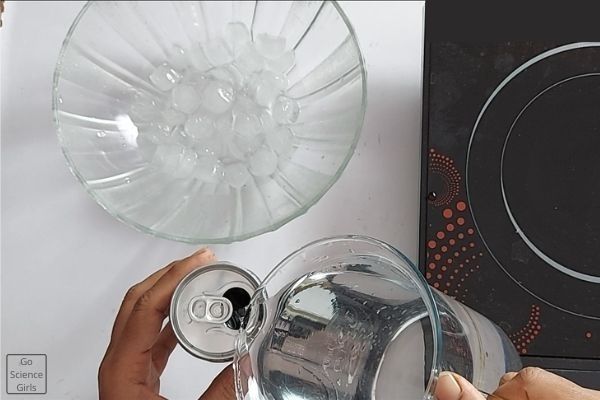
Now it is time to fill the cleaned empty soda cans with a little amount of water. 2-3 table spoons of water is more than enough to pour into the cans.
Normal and regular water is preferred to use. But make sure the water you are using is fresh and clean.
Step-4: Heat the Cans
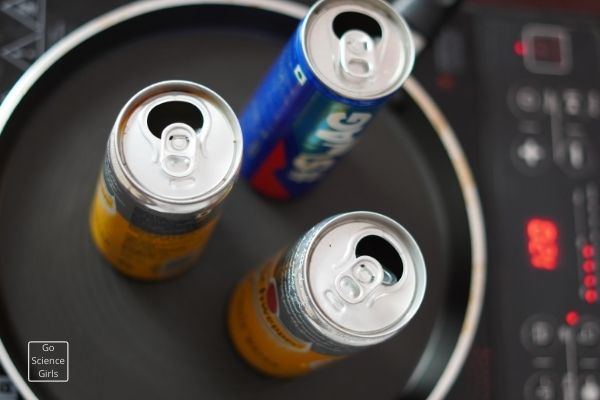
The next step is the precautionary step as we are bringing burner into the picture. Yes, switch on the burner and take the water filled cans on to the burner. You can see the videos or pictures attached to get an idea.
We took three empty cans and filled with 2 table spoons of normal water. Then, we brought all these three water filled cans on to the burner and set the right temperature to make it boil.
Wait for some time until the water inside the cans are boiled enough. It just takes a couple of minutes to do the job.
Note: If your child is performing this experiment on his/her own, then this is the step where adult supervision is compulsory to avoid unnecessary accidents that happen with the heat. So, adults please supervise your children to heat the cans on the burner.
Step-5: Take out the Heated Can
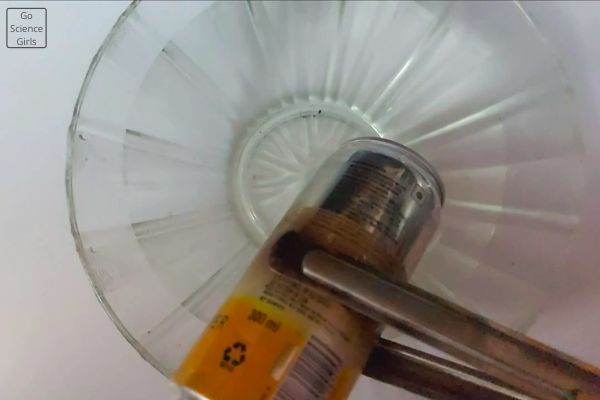
Once you feel the sounds of water bubbles formed due to enough heat supplied to the water inside the cans, wait for one more minute.
And then observe the water vapor fumes coming out of the cans. That is the time, you need to switch off the burner and take out the cans from the burner.
Do not forget to use the tongs in order to handle the heated cans.
Step-6: Place over the heated can upside down into the Glass Bowl
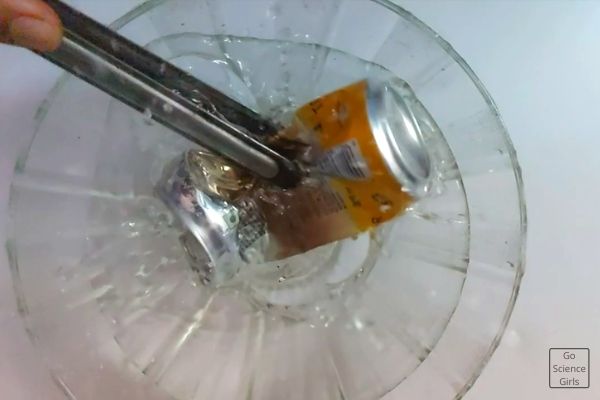
This is another important step to do with extra care!
Yes, to see the positive results, you need to perform this step with utmost care.
Soon after you remove the cans from the burner, using tongs place the cans over the glass bowl filled with cold water.
The trick here is you need to place the cans upside down into the glass bowl. That’s it! You can see and hear a loud noise of popping out sound from the can.
Can you guess why we hear that sound? That’s the sound of the crushing can!
As soon as the heated cans brought in to the glass bowl filled with cold water upside down, the cans get crushed and collapses on their own.
Crushing Can Experiment Calculations
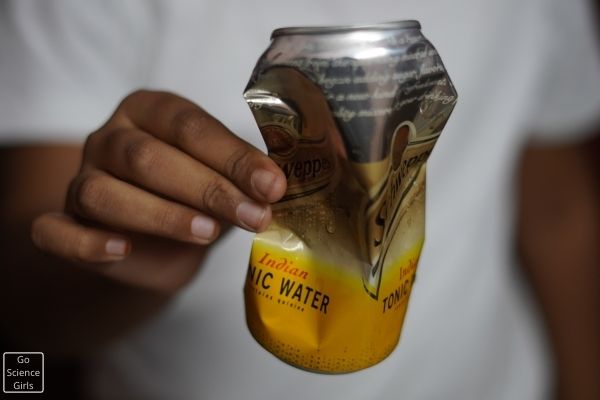
In this modern world, we generally come in touch with 12oz drink cans like soda or beverages can.
Mostly, we find them in aluminum material. The approximate measures of these cans are like: 4.75 inches or 12cm in height and 2.5 inches or 6.5cm in diameter which in total makes the whole area of this cylindrical can to 49.5 square inches or 315 square cm.
The dimensions of the cans are also designed specially in order to withstand the outside pressures. A square inch of a soda can bears 80-90 pounds of force from outside.
One atmosphere pressure force is equals to 720lbs or 3200newtons. So, in order to crush a soda can, you need to give nearly 50 pounds of force.
Do you want to know what the science behind Crushed Can?
An empty aluminum soda can is full of air molecules. When you apply enough force or pressure on the can from outside, there happens an imbalance between the pressures outside and inside the can.
In fact, the pressure outside the can is stronger and more than the pressure inside the can.
At the time, the can from outside experiences enough pressure, it collapses and gets crushed immediately. This is how air pressure plays important role in crushing an aluminum can in our hands.
Let us know what is air pressure? Air pressure is the pressure or force created by the surrounding air on the surfaces within the atmosphere as gravity pulls. Hence, it is otherwise known as atmospheric pressure.
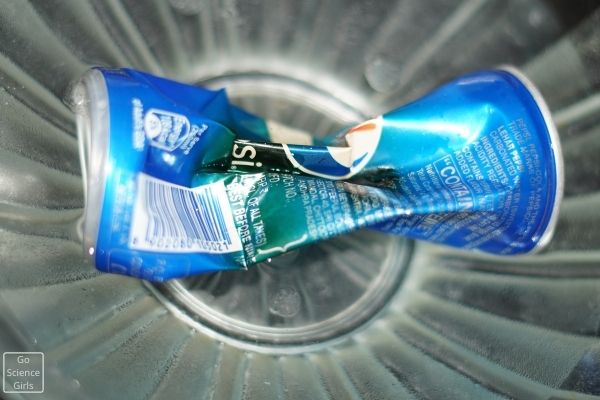
Science behind Crushing Can Experiment
As I already told you, the empty can is not really empty instead filled with air molecules.
When the can filled with little water and arranged for heating on the burner, the water inside the can starts boiling.
Once the water starts boiling, there happens the transformation of liquid state to gaseous state.
This means we can observe water vapors coming out of the can through the fumes. Evaporation is the process of converting liquids into gases, which is the result of heating cans on the burner.
Eventually, the can is filling with vapors replacing the air molecules. Soon after you remove the cans from the burner and bring it over the chilled water in a bowl, the water vapor condenses.
You can see the condensation process clearly when there is formation of a few drops of liquid back on the can inside.
Unfortunately, these little liquid droplets are not strong enough to produce enough pressure inside the can. That is the reason the pressure outside the can is much more and stronger than the pressure inside the can.
Hence, the strong pressure developed outside the can is good enough to crush the can from outside.
Here, we need to talk about “Implosion”. Implosion is nothing but a sudden process of something collapsing themselves towards inside violently.
Implosions happen when there is heavy pressure from outside an object rather inside and finally destroys the object inwards. Explosion is quite opposite to implosion.
Matter and energy plays important role in causing explosions and implosions.
In this experiment, due to imbalance of pressures between outside and inside surroundings of can, implosions happens.
Because to maintain and bring the balance between outside and inside pressures of can.
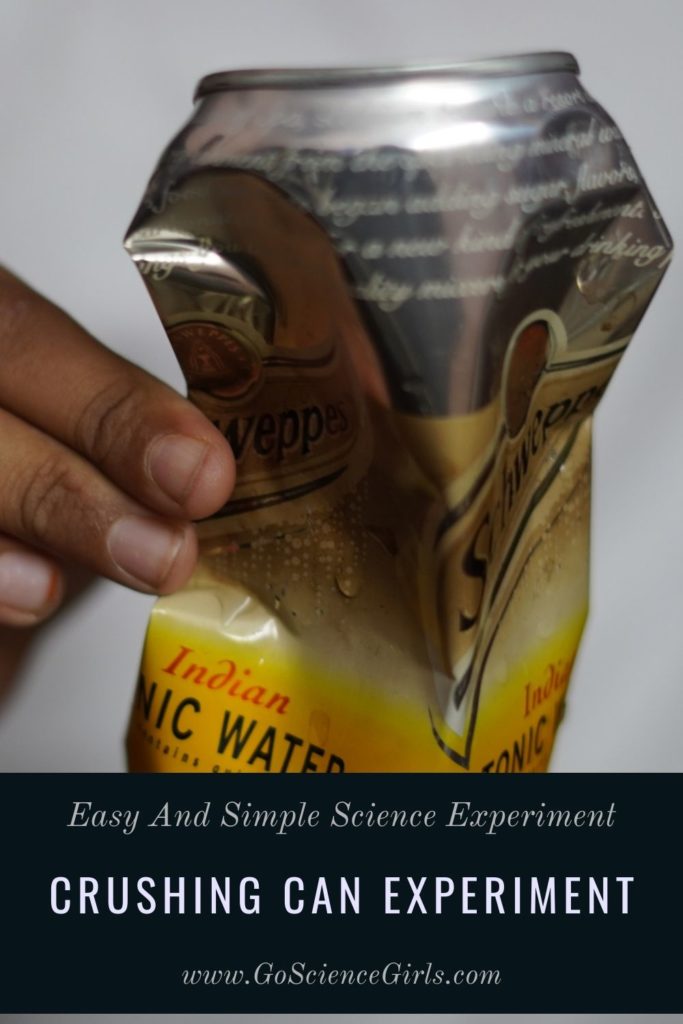
What happens after Implosion?
After implosion, just observe the inside of the can, you can observe water filled inside the can. This is the water dragged from the glass bowl due to stronger pressure build outside the can.
This high pressure created pulls the water from the glass bowl into the can where there is less pressure.
What is Gas Law and How it works?
Gas laws are the laws which establishes the association among pressure, volume, temperature, and the quantity of gas. In simple words, gas laws were designed around 16th-17th century to learn the amazing properties of matters of gas regarding amount, volume, pressure, and temperature.
Generally, there are different types of gases available and all these gases behave differently while showing their chemical properties but strictly follow gas laws in the same way.
PV = nRT
P= Pressure
V= Volume
n= Amount of Substance
R= Ideal Gas Constant
T= Temperature
The three principal and basic laws of gas includes: 1) Boyle’s Law
2) Charles Law
3) Avogadro’s Law
These three gas laws states different equations and properties but at the end they all come under Ideal Gas Law and General Gas Equation. Well, let us the three main gas laws in detail:
Boyle’s Law
Robert Boyle put Boyle’s Law into words in 1662 stating that the pressure of a gas is inversely proportional to volume of a gas. To keep it simple, if there is less volume of gas then there is more pressure on the gas at constant temperature. This law is otherwise known as Boyle–Mariotte law or Pressure-Volume Law.
V is inversely proportional to 1/P
Charles Law
Jacques Charlesformulated Charles Law that states that when pressure remains constant, the volume of stable amount of gas is directly proportional to temperature. In simple words, the rise in the volume of gas tends to increase the temperature as well. This law is otherwise known as Temperature-Volume Law.
V T
Avogadro’s Law
Amedeo Avogadro established the Avogadro’s Law which states that volume of a gas is directly proportional to amount of gas at constant temperature and pressure. Modern Avogadro’s Law states that equal amount of volume of gas consists of equal amount of molecules at constant temperature and pressure. This law is otherwise known as Volume-Amount Law.
V n
All these experimental gas laws are a part of Ideal Gas or General Gas Equation Law. Let us see what ideal or general gas equation law is.
Ideal Gas Law
Ideal Gas Law is also known as General Gas Equation Law. It states that it is a combination of all three gas laws and finally proves that pressure, volume, temperature, and amount of a gas relate each other. The gases that are fit to establish perfect relation between volume, temperature, pressure, and amount of gases are referred as ideal gases. The equation says:
PV = nRT
FAQ’S
When the aluminium can is hot, the pressure outside and inside the hot can are same. And when it is flipped upside down over the glass bowl containing cold water, immediately you can see sudden drop in temperature.
Hence, the water molecules get cool rapidly causing imbalance in the outside and inside pressures around the can.
The pressure outside the can is stronger and more compared to the pressure inside and hence the can pops out and collapses itself towards inside.
Crushing Can Experiment proves the Boyle’s Law, which is one of the major fundamental and experimental gas law of ideal gas equation law.
Boyle’s law states that the volume of certain amount of gas is inversely proportional to pressure of a gas.
According to the sources and research studies, 10-20 pounds of force is necessary to crush an aluminium can.
If you just want to open the mouth of the aluminium can, you need 1-2 pounds of force.
Whereas nearly 50 pounds of force is necessary for crushing a steel beverage can. Remember that these numbers are just an estimated ones.
Take an empty aluminium soda can and pour two table spoons of normal fresh water. Now bring the can on to the burner and heat it until you hear the boiling water sound.
When you observe the steam coming out of the can, switch off the burner.
And pick the hot can using tongs and carefully flip it upside down over the glass bowl containing chilled water. That’s it, you can see the hot can crushing with a pop sound.
Jacques Charles formulated Charles Law that states that when pressure remains constant, the volume of stable amount of gas is directly proportional to temperature.
In simple words, the rise in the volume of gas tends to increase the temperature as well. This law is otherwise known as Temperature-Volume Law.
V T
Soda cans are generally encompasses of aluminium to keep its structure solid and strong enough to withhold the outside pressures.
A regular soda can bears 80 pounds-90 pounds of pressure per every square inch. According to the research studies, 1pound-2pound force is necessary to open the mouth of the soda can whereas to crush it completely, nearly 50 pounds of force is necessary.
We have so many real life examples to discover Charles law around us but we just ignore to observe. Here is a classic example: the tyres of vehicles get deflated during chilled winter season whereas the same gets inflated during summer months: this phenomenon is due to
Charles Law. During winter days, because of chilled temperature, the gas inside tyres get more cool and starts shrinking as well. While during summer months, due to hot temperature the sir inside tyres gets hot and starts expanding. This is the reason why tyres of some vehicles expand during summer and deflate during winter months.
Charles law does show its impact on human body but it is not much. You all might have observed shortened breath during winters and normal breathing during summer months.
This is because of Charles law. Yes, during winter months, the chilled temperature outside causes the change in inside temperature of lungs. The inhaled cold air when passes through sinuses, gets warmed and expands in its volume.
When the volume increases, you need to take shorter breaths in order to balance the increased volume. In this way, Charles law affects human body.
A: In real life, we can observe a lot of things happening around us which are actually related to ideal gas laws. Let us see a few of commonly happening things:
1) An inflated football shrinks when left aside during winter months—Proves Charles Law
2) Leave the slightly inflated rubber life raft under sun light for some hours and observe the swelling of the raft– Proves Charles Law
3) Increase in number of bubbles blowing out by a scuba diver especially when approaching the surface or river banks—Proves Boyle’s Law
4) Death of deep sea fish when brought to the surface or land– Proves Boyle’s Law
5) Expansion of lungs when filled with air and shrinks when air released—Proves Avogadro’s Law
6) Humid air is more thick than damp air—Proves Avogadro’s Law
Gases have low densities than solids and liquids because in solids and liquids the molecules are tightly and narrowly filled.
Whereas gaseous molecules do not pack up closely and occupy more volumes because these molecules fall apart. This is the reason why gases have low densities.
Before heating, the air pressure outside and inside the open soda can measures equal. Because the open can is not really empty instead occupied with air molecules.
When you pour two table spoons of water inside can and kept on the burner, the water reaches its boiling point and leaves steam. This steam occupies the rest portion of the can inside and substitutes all the air molecules.
The process of conversion of a gas into a liquid is known as condensation. The reverse process of conversion of a liquid turning in to gas is known as evaporation. Evaporation and condensation are the nature’s fundamental phenomenon and goes hand in hand.
Crushing Can Experiment Worksheets
Simple worksheet for Class room : https://www.wlwv.k12.or.us/cms/lib/OR01001812/Centricity/Domain/2114/Can%20Crush%20Key.pdf
https://www.csub.edu/chemistry/_files/The%20Can%20CrusherAO.pdf
Explanation with method to do the experiment in large setup : https://www.flinnsci.com/api/library/Download/12267d76eaf04431b63a82777bb16195

How is the can crushed if it is not sealed? Surely it would simply suck up the cold water you mention that is used for condensing the steam.